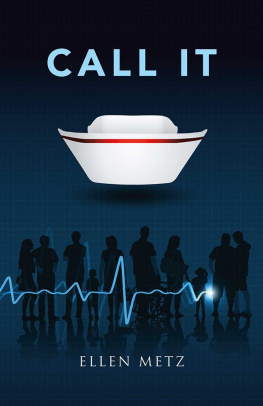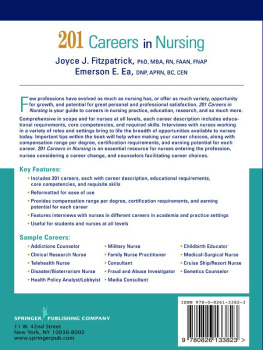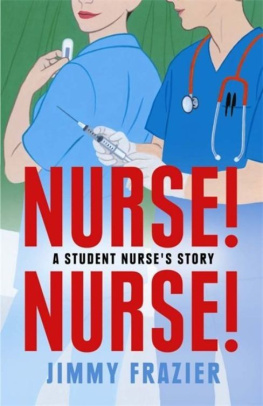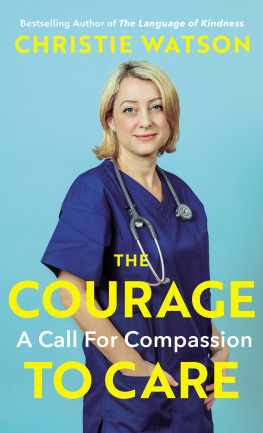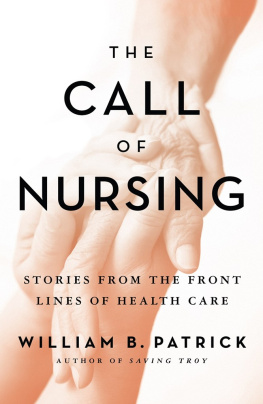Call It
Copyright 2018 by Ellen Metz
All rights reserved. This book or any portion thereof may not be reproduced or used in any manner whatsoever without the express written permission of the publisher except for the use of brief quotations in a book review.
ISBN (Print Edition): 978-1-54392-649-1
ISBN (eBook Edition): 978-1-54392-650-7
Prologue
The Emergency Department

1990
My coworker and I shoved a red metal cabinet on wheels from the hallway into a treatment room next to an empty stretcher. It looked like an ordinary tool cart you might see in an automotive garage. I quickly twisted off a small disposable lock, so we could open the drawers and pull out prefilled syringes of emergency drugs. I stabbed a bag of intravenous fluid with some plastic tubing, and then primed the tubing with the fluid so it was ready to be attached to the patient. My coworker pulled out the syringes of the drugs used for resuscitation. Then we both put on paper gowns and latex gloves and waited for the emergency squad. They were on the way with a three-year-old boy, found unresponsive and floating in his parents backyard pool. We tried to control our adrenaline, but no matter how many times we had been through this, a life-and-death call from the EMS (emergency medical services) still felt like an electric prod applied directly to our nervous systems.
The paramedics were performing CPR as they rushed through the door. I looked at the tiny body and knew the situation was probably hopeless. The boys color was bluish-grey, his limbs were flaccid, and Oh God, I suddenly realized, hes the same size and age as my son .
The ER doctor and other nurses joined us at the bedside. Someone cut off the boys clothes as one of my teammates hooked him up to the cardiac monitor. All motion paused momentarily while everyone looked at the monitors screen. He was a straight linehis heart was not beating.
Continue CPR, the ER doctor said. He turned and asked the squad paramedics for the time of the boys last dose of epinephrine. Repeat the epinephrine, give me the ET tube! he shouted.
The ER nurses relieved the paramedics and continued performing CPR, then the doctor inserted the ET tube, a plastic tube that is inserted down the throat for better oxygen delivery. We gave the boy multiple doses of intravenous medications in addition to the oxygen. As each medication was given I recorded the time. The boys heart did not respond, and we all knew the outcome was inevitable.
The ER doctor finally said, Call it, and one of the nurses looked at the clock on the wall.
Time of death, five-fifteen p.m. , the nurse said. And so it was recorded.
A sense of devastation loomed in the air because the victim was a child. Then everyone except me left the room to return to the other patients. I had charting to complete, and then I would make the call to the coroner.
Whenever we resuscitate a patient, one nurse is designated to follow up with the family and complete the paperwork. We take turns performing this duty; that evening, it was my turn. I gagged back my tears and wiped the boys face with a washcloth then smoothed his hair down, attempting to make him more presentable for his family. I bagged up the remnants of his clothes, including a tiny pair of underpants that were stained from an opened sphincter he had when he gave up his life.
The parents were in the quiet room that was used for life-altering conversations. I had been present at many of these conversations but had not dealt with the death of a child since I had become a mother. The mother was talking with another nurse when the doctor and I entered. Her conversation was nonsensical; she wasnt ready to acknowledge what had happened, and her mind had clearly left the current time and place. The father filled in some pieces, he said his wife had spotted the child floating in their above ground pool from an upstairs window. His older brothers had apparently left the ladder on the pool; they were just school-age kids. It was all an accident.
The father asked to see his son, and I took him to the room. He looked, and then he backed up to the wall for support. I didnt have much to offer other than my presence and a hand. I have no idea how long we stood there before we returned to the quiet room. As was customary, I asked the parents if they wanted to call a minister and if they wanted the name of a funeral home. In less than an hour, the child was picked up and the parents had returned to their home.
While restocking the red metal cart, I saw our ER doctor in his office, sitting at his desk and staring into space. I stopped what I was doing, walked into his office, and sat down in the chair across from him. We shook our heads in sadness. I didnt know him well, but I knew he had a young child at home. Miraculously, I was still able to control my tears.
When I arrived home after midnight I changed my clothes. Only then did I sit and allow myself to cry. I poured myself some whiskey, downed it, and then continued crying so hard that I retched. I woke my husband and told him what had happened. He listened, patted my arm, and fell back asleep. He couldnt comprehend the events in the ER because he hadnt been there cleaning that little body. I didnt fall asleep until the early hours of the morning.
The tears started again the next morning as I dressed my son and made breakfast. Sadness was perceptible that evening among the returning nursing staff. We all wondered how the mother was doing. We could all relate.
When the weekend arrived, I went alone to the lake near our home. The sight and sound of the water on the rocks were soothing, but I knew it would take some time to get over this. The instructors in nursing school had never taught us how to deal with tragedy.
A few months later, a thank you note arrived from the childs mother. She talked about acceptance and her belief in a higher power.
Chapter One
Nursing School

September 1969
My parents and I entered a brick building that had been built circa 1900. We saw a small sitting room on the left and a wooden counter on the right. A shelf with cubby holes was mounted on the wall behind the counter. The entire room looked like it could have been the registration area at an old hotel. An elderly woman behind the desk greeted us then sent us down the hall toward a reception room.
The room was large, with a collection of dated and mismatched furniture arranged on a wood floor. Waist-high bookcases lined two of the walls. The center of the room was anchored by a rug and had a television, a couch and a couple of chairs. A ping-pong table, sat in a back corner. Smiling women at fold-up tables waved us over. They introduced themselves as students and instructors and handed me a class schedule, several information packets and my room keys.
I had no frame of reference about nursing on that day, other than some sketchy memories of a book series I had read in middle school. The series featured a nurse named Cherry Ames, who solved mysteries like Nancy Drew. I decided to become a nurse after a chance encounter with a high school friends older sister. She was in nursing school, and, one day, while I was visiting my friend, her sister had come home wearing her student uniform. She dropped a starched white nurses cap and a pile of medical books on the kitchen table. She looked important .

